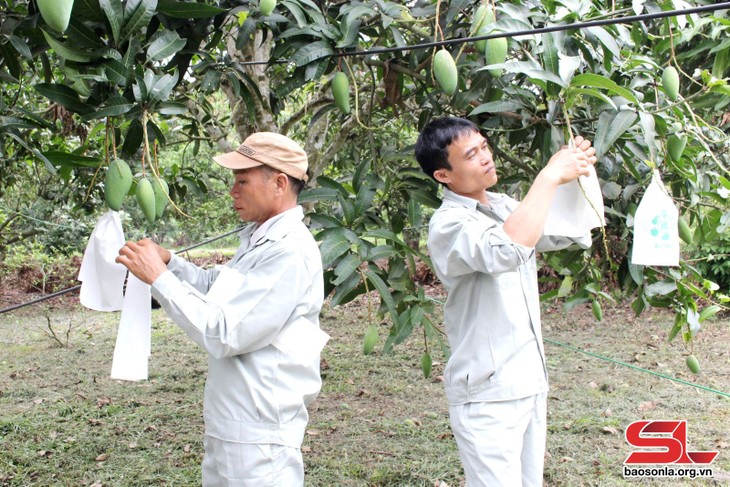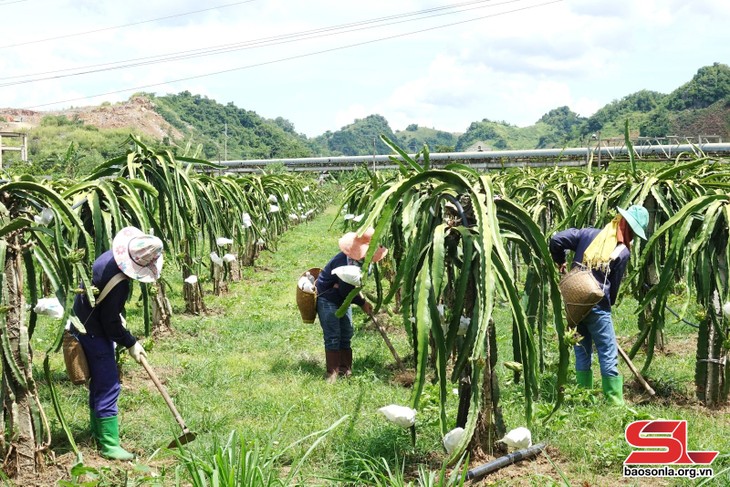(VOVWORLD) - To export key farm produce to the world market, the northern mountainous province of Son La has improved the quality of, developed more planting area codes, and formed specialized production areas in line with quality standards such as Vietnamese Good Agricultural Practices (VietGAP) and Global Good Agricultural Practice (GlobalGAP).
 Members of Chieng Hac Safe Agriculture Cooperative in Yen Chau district wrap mangos in wax paper bags. (Photo: baosonla.org.vn) Members of Chieng Hac Safe Agriculture Cooperative in Yen Chau district wrap mangos in wax paper bags. (Photo: baosonla.org.vn) |
Developing growing area codes is a mandatory requirement for exported agricultural products and has a positive impact on the farmers’ mindset and production activities.
The family of Nguyen Tien Hoi of Quyet Tam Fruit Cooperative in Yen Chau district has more than 3 hectares of mangoes, two of which have been granted growing and production area codes in accordance to VietGAP process.
The orchard produces dozens of tonnes of fresh fruit each year, generating a stable source of income for his family.
“Every year, we harvest 35 to 50 tons of mangoes alone, about two thirds of which meet export standards. Thanks to the planting area code, the exporting has been more convenient,” said Hoi.
Yen Chau district has over 11,300 ha of fruit trees, 7% of which have been certified with VietGAP standards. It is managing 67 growing area codes for more than 1,100 ha of fruit trees of various kinds. More and more crop growing areas in the district have applied high-tech methods to improve product value and have been provided with codes, which facilitate export.
Duong Minh Ha, Director of Quyet Tam Fruit Cooperative, said this gives local cooperatives the advantage when exporting agricultural products to the world.
He said, “A planting area code makes our management and farmers’ production in line with VietGAP standards easier. Product quality is much higher than using the traditional farming techniques. The growing process is thoroughly recorded.”
A growing area code not only helps trace the origin, but also strictly manages the production process to create trust for consumers. It helps people shift from small-scale production to linking with others to form specialized and large-scale production areas.
More particularly, special attention has been paid to the quality and branding of products, meeting the strict requirements of import countries. As a result, export markets have been expanded.
Ha Van Son, Director of Chieng Hac Safe Agriculture Cooperative in Yen Chau district, said, “Since being granted a planting area code, our cooperative members have strictly complied with set regulations to serve exports, including the use of fertilizers and plant protection products.”
 Blue dragon, one of Son La’s agricultural products to be granted with a planting area code. (Photo: baosonla.org.vn) Blue dragon, one of Son La’s agricultural products to be granted with a planting area code. (Photo: baosonla.org.vn) |
Son La province has more than 280 planting area codes on a total area of 4,600 ha, in which more than 200 codes are used for growing areas for exports, mainly for longan, mango, banana, plum, and dragon fruit.
Duong Gia Dinh, Director of the provincial Cultivation and Plant Protection Sub-Department, said this helps create a legal corridor for Son La's agricultural products to penetrate 21 countries and territories.
“A planting area code is very important in agricultural production, especially, when Vietnam's agriculture and economy are integrating extensively into the world and farm produce is a major hard currency earner,” said Dinh.
The granted areas, 4,600 ha to date, are not much in comparison with Son La’s potential, as they account for 5.5% of the total available fruit tree area in the province.
But a planting area code has changed farmers’ mindset. The locals have taken the initiative in applying high-tech advances to improve product quality and meet export requirements.
According to Nguyen Dinh Tuan, Director of Doan Ket Cooperative in Mai Son District, once applying the VietGAP model, the herbicides and pesticides on the banned list are no longer used.
“We use organic fertilizers and the approved pesticides for the entire planting area. Priority is given to probiotics,” Tuan noted.
The building of planting area codes for farmers, cooperatives, and businesses in Son La has accelerated digital transformation in agricultural production, increased productivity, and reduced labor for farmers. More particularly, the move has added value for agricultural production, helping increase the export of Son La’s agricultural products.